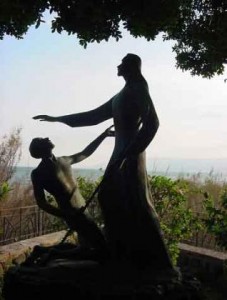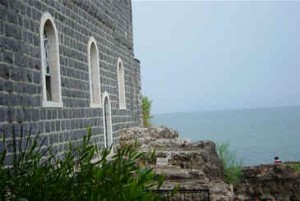There is no place around the Sea of Galilee where the traditions of Jesus and his disciples are more prevalent than at Tabgha on the Northwest coast. There is also probably no place with more natural beauty; with lovely flowers; the flowing of pleasant springs; and abundant shade trees. The site is today probably one of the most popular pilgrim sites in the land of Israel.
Some New Testament events commonly associated with the Tabgha area are the reinstatement of Peter, the miracle of loaves and fishes and the miraculous catch of fish. It is thought that early believers at nearby Capernaum may have kept these traditions alive until they could be enshrined with church buildings in the fourth century.
The dual site of Tabgha today contains two Catholic shrines built in the twentieth century; The Church of the Multiplication and the Church of the Primacy of Peter. These modern churches are built over the ruins of ancient fourth and fifth century structures. Parts of the ancient fourth century foundations can still be seen in the Church of the Multiplication. In that church can also be seen some of the finest mosaic floors in Israel. These mosaics from the fifth century include the famous one of the loaves and fishes.
HOW DID TABGHA GET ITS NAME?
Where did the name “Tabgha” come from? Apparently it is a corruption of the Greek name “Heptapegon” meaning “seven springs.” In time, it was shortened to Et-Tapega and then simply to Tabgha. There is still plenty of evidence of the springs from which the area is named. Spring-fed streams still meander through the church grounds. In several places the springs can be seen emptying into the Sea of Galilee. Just a short walk from the Primacy of Peter Church, there is a large spring which at one time was capable of turning a flour mill.
The springs of Tabgha are unique in that they are warm, with temperatures varying from 84-86 degrees (29-30 C). It was at these springs that New Testament fishermen often gathered in pursuit of the Talipia, also known as the St Peter’s Fish. The Talipia, being a tropical fish, found it difficult to survive the cold winter months in the Sea of Galilee. In order to so, the fish swam in great numbers to the warm springs of Tabgha.
One local fisherman and renowned expert on ancient fishing is Mendel Nun. Nun declares that until the 1940s, Tabgha was still a wonderful place to fill his nets with St. Peter’s Fish. Even today, it is not an uncommon sight to observe fishermen with their nets at Tabgha. Since the fish still arrive at the area in great numbers, the biblical story of nets so full they were breaking is certainly verified. For modern pilgrims, the good news is that the mouth-watering Talipia are still served at many restaurants around the sea.
An interesting thing can often be observed along the shoreline at Tabgha. The Jewish fishermen who still work in the area, often toss catfish upon the bank to decompose. These large and lazy fish are plentiful in the Sea of Galilee, but according to biblical law they are unclean for Jewish fishermen (Lev. 11:9-10). Tabgha thus makes the parable of the net come to life (Matt. 13:47-50). We realize that not all who are called will be chosen (Matt. 22:14). It is true with followers and with fish that there are the clean and the unclean. In the last day, the angels of God will separate these “kosher” from the “non-kosher”. The Lord will take the good for himself and the bad he will cast away.
JESUS AND HIS DISCIPLES AT TABGHA
In the Gospel accounts we see the disciples assembling once more in the Galilee at the request of Jesus. Where else but at the old fishing hole  would Peter probably decide to go fishing once again? After all, he had denied Jesus three times and in his apparent discouragement he seemed to be returning to his old occupation once more. However, during the night of fishing, Peter and the disciples who joined him caught nothing.
would Peter probably decide to go fishing once again? After all, he had denied Jesus three times and in his apparent discouragement he seemed to be returning to his old occupation once more. However, during the night of fishing, Peter and the disciples who joined him caught nothing.
In the morning, they were amazed to see their risen Master on the beach. He had already prepared a meal of fish and bread for them. He then directed the tired fishermen to cast their net once again on the other side of the boat. In so doing they caught a great number of fish, 153 in all. With this, Peter seems to have permanently forsaken any idea of fishing. From this point on he would become a true “fisher of men.”
There were several miracles that morning in the Galilee. It was a miracle that Jesus was risen from the dead and present again with the disciples. It was a miracle that he had prepared a breakfast for them. It was also a miracle that they suddenly caught so many fish after fishing empty-handed all night. It was another miracle that the nets didn’t break with so many fish in them. Lastly it was a miracle that the fish couldn’t see the nets in the daytime. In ancient times, with the absence of synthetic fibers, fish could see nets in the light of day and it was thus necessary to fish at night.
Traditions abound that all these miracles happened at Tabgha. In the late fourth century, a Christian pilgrim by the name of Egeria visited this area. She was such a accurate and copious note-taker that today archaeologists use her notes to try and piece together the locations of authentic biblical sites. Egeria remarked that the site of all these miracles could still be identified in her day by some steps hewn into the stone and leading down to the water. Today these steps can still be seen by modern pilgrims.
THE REINSTATEMENT OF PETER
It was very likely that at Tabgha Jesus reinstated the disciple Peter (Jn. 21:1-24). He had denied Jesus three times, and it is interesting that Jesus also tested his love and devotion three times. Jesus then walked away from the area with a renewed and restored Peter following close behind him.
Some unknown centuries ago it is likely that Christians placed several large heart-shaped stepping-stones along the shore at Tabgha. The stones almost cry out the message of John 21:15: “…Simon son of John, do you truly love me more than these?”
What a question for modern disciples to ponder! For Peter, the “these” in his life were probably fish, nets and fishing boats. As modern disciples, we will have to find our own answer to Jesus’ question. We will have to decide what the “these” are in our own lives.
This updated article is presented courtesy of Bridges For Peace, Jerusalem.


